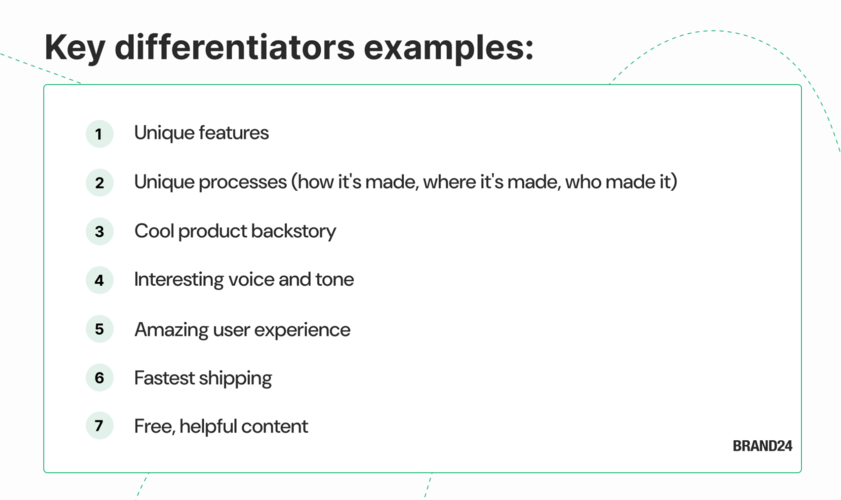How to Do a Competitive Audit? The 7 Step Guide [2026]
Table of contents
Running a business without checking out the competition is like showing up to a party without knowing the dress code – you might think you’re killing it, but you could be totally off.
A competitive audit is your insider pass to see what everyone else is doing, find out what’s working, and where you can improve.
It’s easier than you think and could give you the edge you didn’t even know you needed.
A competitive audit is the process of analyzing your competitors to understand their strengths, weaknesses, and marketing and pricing strategies. It helps you find growth opportunities, improve marketing, and strengthen your competitive edge.
So, do you want to conduct a competitor audit?
Here’s a step-by-step tutorial with some insider tips!
What is a competitive audit?
A competitive audit, or a so-called competitor audit, is the process of analyzing your competitors to understand their strengths, weaknesses, strategies, and how they position themselves in the market.
This audit helps you identify opportunities for growth, improve your marketing strategies, and sharpen your competitive edge.
Why should you conduct a competitive audit?
A solid audit helps shape your marketing strategies and gives you a clear path for what to do next.
It also sets benchmarks to track your business’s progress.
Conducting a competitive analysis allows you to:
- Identify gaps in your own strategies and adjust accordingly.
- Understand the strengths and weaknesses of competitors.
- Stay updated on market trends and shifts.
- Build stronger value propositions for your brand.
- Identify new potential customers.
- Get inspired by competitors’ content and marketing tactics.
Pro Tip: Ask AI tools for audit
AI technology is an absolute game-changer to conduct a competitive audit.
I honestly can’t imagine having to identify all metrics on my own and conduct the competitive analysis manually.
So, I tested using AI Brand Assistant to create a competitor audit for Qatar Airlines. I wanted to identify its competitors and benchmark against them.
Plus, I went a step further and asked for an analysis of specific marketing efforts – like addressing new regulations and policies.
Here’s a competitor audit about sustainability for airlines:

And about new regulations:

And here’s the fun fact: I didn’t even know what kind of new regulations were introduced for airlines – I just asked the AI.
During that process, I created this list of ready-to-use prompts to get a competitive analysis from an AI tool.
I don’t want to over-clutter this article with AI analysis examples, so you have to believe me – the answers were impressive, and you should definitely give it a try!
Here’s what prompts I used:
- What are the key strengths of the [brand’s] competitive strategy?
- What weaknesses should [brand] address to improve its market position?
- Who are [brand] main competitors, and what are their strengths and weaknesses?
- What is [brand’s] unique value proposition?
- How is [brand] perceived in the market?
- What market share does [brand] currently hold, and how has this changed over the past quarter?
- What are the most significant threats from new entrants in [brand’s] industry?
- What distribution channels do competitors use, and how does [brand’s] approach differ?
- What are the strengths and weaknesses of [brand’s] marketing and promotional efforts compared to competitors?
- What technological advancements have competitors made, and how does [brand] compare in terms of innovation?
- What are the key differentiators that set [brand] apart from its competitors?
- What regulatory or legal challenges are affecting the industry, and how are competitors addressing them?
- What partnerships or alliances have competitors formed, and how does [brand] compare?
- How sustainable or environmentally friendly is [brand’s] product or service compared to competitors?
- What trends or consumer demands is [brand] not addressing that its competitors are?
You can copy these questions into Brand Assistant or a similar AI tool to generate immediate results.
How to do a competitive audit?
AI tools are great, but if you want to do it on your own – here’s a step-by-step tutorial.
Step 1: Identify your goals and objectives
Before starting the audit, identify your goals and objectives. What specific questions do you want to answer with this competitive audit?
The most common goals of a competitive audit are:
- Identifying direct and indirect competitors
- Understanding the target audience and their needs
- Analyzing the competitive landscape and market trends
- Identifying opportunities to improve your marketing strategy and value proposition
- Informing product development and pricing strategy
Step 2: Identify competitors
Identifying your competitors is a critical step in the competitive audit process.
You need to identify both: direct and indirect competitors.
- Direct competitors are companies that offer similar products or services to the same target audience.
- Indirect competitors, on the other hand, offer different products or services that meet the same customer needs.
For example, if you’re a coffee shop, your direct competitors might be other coffee shops in the area, while your indirect competitors might be restaurants or cafes that serve coffee.
To identify your competitors, you can use a variety of methods, including:
- Online research
- Customer surveys
- Industry reports
Plus, some platforms, like Semrush’s Market Explorer, offer a dedicated tool for a competitor’s research.
Market Explorer provides a list of the top players in your specific market. Selection criteria include their total, direct, referral, search, social, and paid traffic volume.
For a detailed guide, check out this article on performing competitor analysis.

Step 3: Collect data through primary and secondary research
Competitive audit without analysis is like playing chess blindfolded – you’re making moves, but you can’t see your opponent’s strategy… and likely lose.
Data is your knowledge and an essential part of any audit.
It sharpens your understanding of competitors’ moves, helping you counter them effectively and build a stronger strategy.
Without it, you’re just throwing punches in the dark, hoping your instincts are enough to land a hit (spoiler: they’re not).
The most essential elements for conducting a competitive audit are:
- Market presence analysis
- Competitive advantage comparison
- Pricing strategies
- Product and service offerings
- Customer feedback and reviews
- Marketing and promotional strategies
- Technology and innovation
- Partnerships and alliances
- Global and local market expansion
- Regulations strategies
You can use these tools to gather data:
- Brand24 for reach, sentiment, platforms, and reputation.
- Semrush for SEO, content, and market share.
- Ahrefs for backlink analysis, keyword research, and tracking competitors’ SEO strategies.
- Sprout Social for social media presence and strategies.
- G2 for gathering insights from real customer reviews and ratings.
Here’s an example of how data from a sentiment analysis can look like inside the tool:


Step 4: Analyze key differentiators
A value proposition is what makes brands stand out.
It’s usually super clear to spot.
For example, Apple is known for its sleek, premium design.
When I think of Apple, I immediately see innovation, simplicity, and high-end quality. That’s their value prop, and it’s consistent across all their products.
Now, what’s your competitor’s value prop?
Keep in mind, products can have more than one differentiator. Usually, each of your products will have its own unique features or selling points. You need to know what those are, plus what people love or hate about them.
Some key differentiators include:
- Unique features
- Unique processes (how it’s made, where it’s made, who made it)
- Cool product backstory
- Interesting voice and tone
- Amazing user experience
- Fastest shipping
- Free, helpful content
These are the things that can set you apart in the eyes of your customers.

Step 5: Conduct a SWOT analysis
A SWOT analysis is essential to identify areas of growth and risk for both you and your competitors.
This approach breaks down into four key areas:
- Strengths highlight what you’re doing better than your competitors and what you can leverage for ongoing success.
- Weaknesses point out where you’re falling behind and need to improve to reduce any negative impact.
- Opportunities help you spot new trends, markets, or segments that you can tap into for growth.
- Threats identify external challenges, like aggressive competitors or shifts in customer behavior, that could affect your business.
Pro tip: Many AI tools can generate SWOT analyses based on your input!
For example, I asked a Brand Assistant to perform a SWOT analysis on a Garmin competitor – Apple Watch, and here’s what I got.
About strengths and weaknesses:

And about opportunities and threads:

Step 6: Benchmark the performance
Now that we’ve got the competitors and the data – we’re all set to benchmark!
It’s a cherry on top of a competitor audit and provides lots of actionable insights.
Let me show you how to do it.
I used Brand24’s “Compare periods” feature to look at Garmin’s and Apple Watch’s performance during recent quarters.
I set up projects for both of the products and went straight to the Comparison tab.
That’s what I got:

It’s clear – Apple Watch still has a larger share of the conversation with 64K total mentions compared to Garmin’s 47K, but Garmin is better in positive sentiment with 35% (16K) positive mentions, whereas Apple Watch saw 22% (14K).
This suggests Garmin users are more satisfied with their products, while Apple Watch continues to generate a larger volume of discussions, whether positive or negative.
Both brands have areas to improve, but Garmin could leverage its positive mentions to amplify its reputation even further.
But during the last months, something unusual happened for Apple Watch – in a periods comparison there’s a clear, sudden spike:

What drove Apple Watch’s recent surge in mentions?

A new product launch!
Identifying any unusual actions and adding them to your competitive audit is a great idea.
In this case, I used Anomaly Detector by Brand24.
My final thought from this competitor analysis is:
- Garmin can capitalize on its customer satisfaction and further strengthen its social presence
- Apple may want to focus its marketing strategy on turning its broader conversations into more positive mentions, especially after product launches.
Step 7: Monitor and review
Monitoring and reviewing are crucial parts of a competitive audit.
It’s not a “set it and forget it” type of thing – you need to keep doing it regularly. Why? Because the market moves fast, and your competitors (probably) aren’t standing still.
Keeping an eye on your competitors is crucial to keep your strategy relevant and flexible.
How often should you do it?
That depends on your industry and how quickly things shift. But generally, if you conduct a competitive audit quarterly or semi-annually, it should do the job.
The important thing is to make monitoring a regular part of your work. When you do it consistently, it becomes second nature, and your team stays focused, agile, and ready to tackle whatever comes next.
Conclusion
A competitive audit is a fantastic way to stay ahead in the market.
It doesn’t have to be a complex and time-consuming process. AI tools can help you conduct one very well.
Whether you’re analyzing your competitors’ strengths and weaknesses or benchmarking performance -these tools can provide valuable insights without your manual work.
Final thoughts:
- AI tools like Brand Assistant simplify the competitive audit process, saving you time and resources.
- Regularly conducting a competitive audit keeps you aware of market trends and competitor moves.
- Use the insights to refine your business strategy, improve customer experiences, and strengthen your target market position.
So, now you’re all set to conduct your competitive audit! Try the Brand24 free trial to simplify this task.


